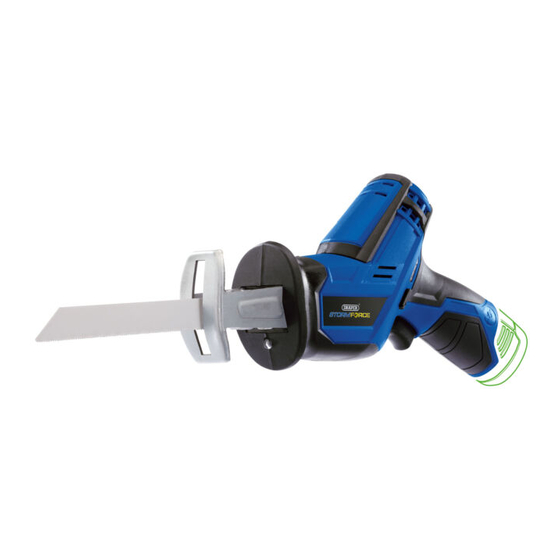Draper 17132 Anweisungen für - Seite 8
Blättern Sie online oder laden Sie pdf Anweisungen für für Säge Draper 17132 herunter. Draper 17132 20 Seiten. Cordless reciprocating saw - bare

5.
HEALTH & SAFETY INFORMATION
5.4 INSTRUCTIONS FOR CHARGERS
AND BATTERIES.
1)
Battery Chargers
a)
Before charging, read the instructions.
b)
For indoor use. Do not expose to rain.
c)
Do not charge non-rechargeable batteries.
3)
Battery
a)
The battery must be removed from the appliance
before it is scrapped.
b)
The appliance must be disconnected from the
supply mains when removing the battery.
c)
The battery is to be disposed of safely.
d)
Do not use non-rechargeable batteries.
e)
Do not crush, open or burn the battery. Exposure
to potentially harmful materials may occur.
f)
In case of fire use CO2 dry chemical extinguisher.
g)
Do not expose to high temperatures >50°C. Cells
may degrade at high temperatures.
5.5 ADDITIONAL SAFETY INSTRUCTIONS FOR RECIPROCATING TOOLS
1.
Reciprocating Saws:
- Always use in conjunction with a suitable dust extraction device.
- Always wear a dust mask and suitable eye protection.
5.6 CONNECTION TO THE POWER SUPPLY
Make sure the power supply information on the machine's rating plate are compatible with
the power supply you intend to connect it to.
This appliance is Class II† and is designed for connection to a power supply matching that
detailed on the rating label and compatible with the plug fitted.
If an extension lead is required, use an approved and compatible lead rated for this
appliance. Follow all the instruction supplied with the extension lead.
†Double insulated
is applied to the basic insulation to protect against electric shock in the event of failure of
the basic insulation.
NOTE: This information relates to the battery charging system for the Draper 10.8V cordless
range.
This product is supplied "bare" which means that it does not have a battery or charger
supplied. Those items are available separately from Draper Tools.
5.6 LITHIUM-ION MATERIAL DATA SHEET
a. As a substance under normal conditions of use it is not considered a hazard to health. In
the event of accidental release, measures to prevent spread must be adhered. Do not
contaminate rivers, waterways or drains.
b. Composition of lithium-manganese, lithium-cobalt and lithium salt as the organic solvent
electrolyte (nonaqueous liquid).
c. Hazardous Decomposition: None during normal operating conditions. If cell is ruptured
hydrogen fluoride and carbon monoxide may be released.
8
: This product requires no earth connection as supplementary insulation
h)
The battery must be charged by a constant
current, constant voltage transformer.
i)
Charge battery regularly in conditions between
5°C to 45°C with the specified charger designed
for this battery.
j)
Store in a dry, well ventilated area within the
recommended limits of 10°C to 30°C.
k)
Do not use battery if it has been stored at 5°C or
less. Allow it to "normalise" at room temperature
before usage/changing.
l)
During decommissioning remove the battery cell
for recycling separately to the product, which is
covered by the waste electrical and electronic
equipment directive. Insulate the terminals with
adhesive insulating tape to prevent a short circuit,
fire or explosion occurring.
